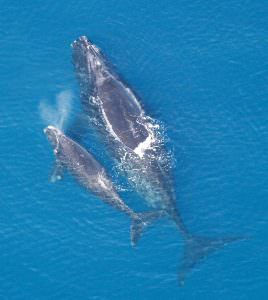 Over the past few years it seems that North Atlantic right whales commonly seen in the Bay of Fundy during the summer months are swimming towards different waters.
Over the past few years it seems that North Atlantic right whales commonly seen in the Bay of Fundy during the summer months are swimming towards different waters.
Researchers who study the black behemoths have noticed fewer of them entering the Bay of Fundy and the Scotian Shelf to find their favorite meal, plankton. Last year a number of the whales were seen further north.
Right whale sightings still on the decline in Bay of Fundy (CBC)
“In the last few years, they haven’t been coming into the Bay of Fundy or they’ve been coming in for a short time and leaving, as though they are not finding food,” said Cathy Merriman, in an interview with the Telegraph Journal. Merriman is a species at risk biologist with the Department of Fisheries and Oceans. “Last year, quite a large number of them were observed up in the Gulf of Saint Lawrence, near the Gaspe Peninsula. So this is relatively new to us.”
The New England Aquarium has counted right whales in the Bay of Fundy since 1980. In years past, there were more than 200 right whales spotted. But in 2013, the researchers counted only five. The next year there was more than 60 whales, but they only stayed for around two weeks instead of a few months. In 2015, only eight showed up.
So why are these huge marine mammals passing by areas they used to be found so often in? Researchers don’t really know. What they do know, through a plankton-monitoring program, is the whale’s food of choice has been found in smaller concentrations in recent years. This could be due to a variety of factors, including water temperature and tidal currents.
“The population is increasing, which is great news, but most of the threats to them are not decreasing,” Merriman said. “The two big ones remain collisions with ships and entanglement with fishing gear. So a lot of organizations are working to try to reduce both things, because more whales means more encounters.”
Right Whales Abandon the Bay of Fundy (Telegraph Journal – paywall)
Earlier this month, new federal regulations came into effect in the hopes of better protecting the traditional feeding and nursery grounds of right whales. Back in 2003, shipping lanes were moved in the Bay of Fundy to make sure large ships wouldn’t strike the animals, one of their leading causes of premature death.
There are known to be around 526 North Atlantic right whales left in the ocean. They spend their winters down south in calving grounds off Georgia and Florida before travelling to find food up north. The low numbers make them one of the world’s most endangered whales.
“It is sad to think that a mazing creatures like the North Atlantic right whale who have relied on the Bay of Fundy for hundreds of years no longer find what they need in our coastal waters” commented Matt Abbott, Fundy Baykeeper for the Conservation Council of New Brunswick. “It is critical that we take action globally to combat the effects of climate change, but also locally to ensure our waters remain the vibrant, productive ecosystem that has made our region famous.”
